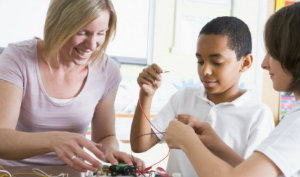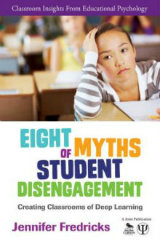Teachers Really Can Engage All Our Students

Student disengagement is one of the biggest challenges middle school teachers face. In most classrooms, there are students who don’t participate, students who are disruptive, students who don’t develop relationships with their peers and teachers, and students who just do what is required to get good grades but fail to truly invest in learning.
In national surveys, between 40 to 60% of students are showing signs of disengagement. Although these statistics are troubling, the good news is that it is possible for you to increase engagement for all students by making changes to both the instructional and social environment.
Examine your beliefs and expectations

Although individual factors do make it easier or harder to encourage interest in school, research shows that the learning context also matters, and you do have the power to create a more engaging classroom. The first step to increasing engagement is to examine your beliefs and assumptions about student engagement. These questions will aid in this reflection:
► Do you think you can engage all of the students in your classroom? Why or why not?
► Why are students disengaged in my classroom? What can I do to increase their level of engagement?
► Are there some students where the problems of disengagement are too large and beyond my control? Why or why not? Who are these students?
Teachers hold lower expectations for their African American and Hispanic students, their low-income students, their low-ability students, and their students who have had a history of behavioral problems. Teachers give their low-expectations students fewer opportunities to learn the material, monitor their activities more closely, and interact less positively with them (Fredricks, 2014).
Likely, you are not aware you are treating these students differently, as these behaviors often reflect our unconscious beliefs about certain groups. In other cases, you may realize you are treating these students differently but feel it is justified because of the students’ ability level and/or home life.
You may try to communicate that you care about these students by demanding less and giving them “one more chance.” This is a mistake. Research with middle school students shows that lower expectations lead to students feeling more alienated and disengaged over time (Fredricks, 2014). It is important to hold all students to high expectations, but also provide the supports they need to do their best work.
Make classroom learning more like learning outside of school
School learning is very different from how learning happens outside of school. In school, students often work alone on problems that have little connection to their lives, share their responses only with their teacher, and often have to wait to get any feedback on how they are doing. These school tasks are often boring and repetitive, and emphasize memorization and applying formulas and procedures. In contrast, in out-of-school learning contexts, individuals work together to try to solve real-world problems and share their findings with a larger group (Resnick, 1987).

Project-based learning is one instructional technique that makes school learning more like learning out in the world. In these environments, students choose a question that is meaningful to them and relates to a real-world problem in their communities or the larger society. Students work together to find an answer to this question and develop a product (for example, a presentation, poster, film, or play) that is shared with their peers and/or a larger community face-to-face or through the internet and social media (Fredricks, 2014).
Although these types of instructional environments are more engaging, they can present additional challenges for both you and your students. It will require a shift from you being in control of your classroom, to an environment where students need to take more responsibility for their own learning.
It is critical in these environments that you play an active role in structuring and facilitating students’ learning experience (Fredricks, 2014). You will need to help your students make good choices, plan and organize their learning, and work effectively with their peers. You will have greater success in these environments if you:
- Provide appropriate amounts of time
- Break tasks into smaller steps
- Select tasks that build on students’ prior knowledge
- Emphasize meaning and understanding over getting the right answer
- Model higher-level thinking and reasoning
- Ask students to provide justifications and explanations
- Make explicit connections between what students are learning and what they already know
- Periodically assess students’ progress and provide feedback
- Provide clear objectives for group work
- Explicitly teach, model, and reinforce social skills for effective group work
- Encourage students to ask questions and monitor their own thinking
Develop personal relationships with all students, not just the easy ones
Another reason why some students are disengaged is that they have failed to develop positive relationships with their teachers. As students transition from elementary to middle school, the quality of their relationships with adults in the school tends to decline. This is more likely to happen with your disengaged students, who often don’t participate and can be disruptive, even defiant.
Students who show interest, are compliant, and participate in class are much easier to teach. You may question whether the time, energy and emotional investment required for developing relationships with the more challenging students is worth the effort. The answer is a resounding yes. Although it takes more effort to develop these relationships, research shows that the benefits in terms of student engagement are significant.

You should also reflect on both the implicit and explicit messages you are sending to your students to make sure you are not contributing to these negative relationships. In middle school, it is also important to give students opportunities to voice their feelings and feel like they are truly being heard.
You also need to let all of your students know that you care for them as individuals and get to know more about their interests and lives outside of your classroom. Finally, it is important to know when you need help from other professionals at the school (i.e., school psychologists, social workers, and special educators) in working with your most disengaged students.
Create a community where all of your students feel like they belong
Developing positive relationships with peers is very important in the middle school years. One reason why some students are disengaged is that they have failed to develop these relationships and are rejected or actively disliked by their peers. This is more likely to occur with students that are aggressive, have difficulty controlling their emotions, and have difficulty reading social cues and making friends their age.
Teachers can play an important role in helping students who have failed to develop positive relationships by:
- Modeling problem solving and conflict resolution skills
- Setting up social situations where students can experience some success
- Providing positive, informative, and immediate feedback regarding social interactions
- Helping student to learn to manage and regulate emotions
- Enlisting the support of school psychologists and social workers for individual and/or group trainings in social skills

- Giving students practice in resolving social difficulties
- Developing classroom norms for appropriate behavior in the classroom, and involving students in creating these norms
- Incorporating collaborative activities that give students practice in making and sustaining relationships with other students
- Providing both formal and informal opportunities for students to get to know their classmates
- Emphasizing individual effort and improvement over competition and relative ability
It’s worth the effort
This sounds like a lot of work. Why should a busy teacher invest the time and effort to increase engagement for all students? First, the middle school years are a key time to intervene to prevent students from dropping out and to help them acquire the skills they need to be college and career ready.
Second, you likely spend much of your time and effort dealing with disengaged students. This reactive approach can be very frustrating and leaves you less time actually teaching. Rather than dealing with problems after they occur, you can be proactive and create an academic and social environment that is more engaging for all of your students.
These efforts will result in fewer behavioral problems, students who are more interested and excited, and students who are more likely to use deep strategies to try to understand the content.

Read our review of Eight Myths here.



































Sounds good in theory, but the majority of middle school math is basics and skills. They are skills needed to be able to do actual real world problems. There are a few areas you could have projects, like Pythagorean theorem, but most don’t lend themselves to real world projects. Building relationships and a community environment are useful practices teachers can use in any subject.
Dealing with middle school kids is very tricky, along with the academics it is very essential the teacher gives them an emotionally safe environment to grow in. They need to feel like they have a voice